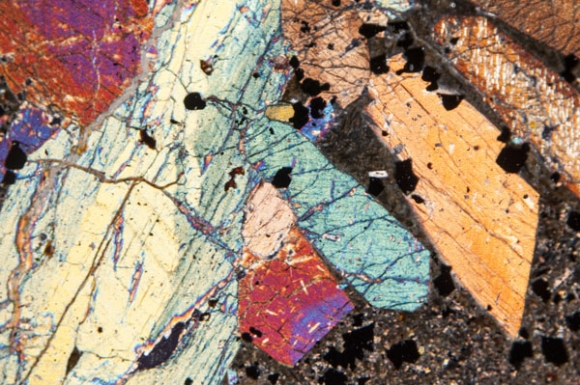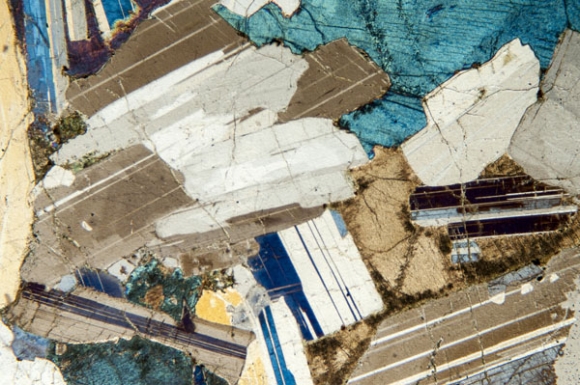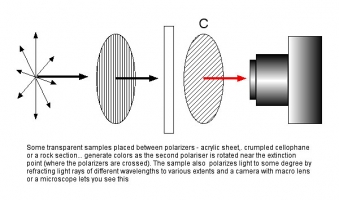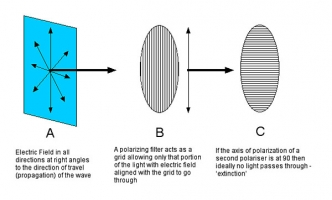Macro photography: hidden rock art and the magic of polarized light
posted Tuesday, January 14, 2014 at 10:28 PM EDT
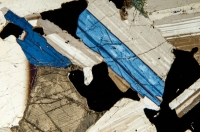
Finding the 'art' hidden in nature has been a lifelong pursuit of mine, originating in my childhood. I scared myself with the faces I imagined lurking in the shadows in my bedroom curtains cast by the glow of a street lamp outside. I do the same now – see faces, not scare myself, that is – in the gnarled boles of ancient trees, those venerable olives and chestnuts planted some 500 years and more ago.
Here, the shapes are obvious for those with an imagination to see them. However, this post is about the less obvious – the abstract art hidden within ordinary-looking lumps of rock, one of the last places you might think to look. The key is not a geologist's hammer to split them open, but rather something much more subtle: making use of polarized light in creative ways.
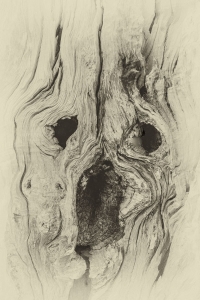
My brother Peter's passion and profession has long involved rocks and fossils and runs as deep as mine does for natural history. Each of us shares the other's interest, albeit not to the same manic extent. Walks together have always been great fun for we read the land in different ways: me the plants, he the rocks and landforms. He came to spend Christmas of 2012 with me in Italy and brought a small box containing a collection of thin, painstakingly ground sections of various volcanic rocks on microscope slides.
By cutting sections of rock with a diamond saw and then polishing them with progressively finer grades of abrasive powders, one can create slivers of rock so thin they become translucent. These rock sections have little to distinguish them, until you place them under a microscope, where the magic of polarized light transforms them. The polarized light reveals bizarre patterns of color that change as you rotate the polarizing filters.
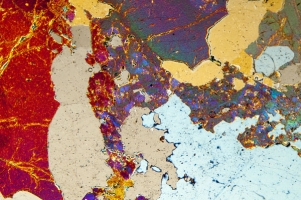
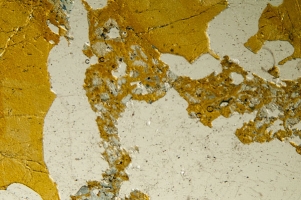
With a petrological microscope, light is first plane-polarized using a polarizing prism beneath the specimen. Then another prism is fitted between the specimen and camera or microscope eyepiece. This second prism is rotated until the two are near the point of extinction. This point is reached when the axis of polarization for the two prisms are at right angles, cutting off the light from each other.
On the precipice of the point of extinction, the polarizers can be rotated relative to one another, revealing the hidden wonders in the microcrystalline structure of the rock.
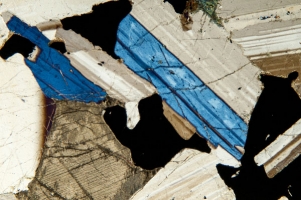
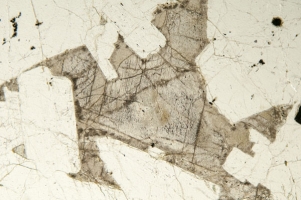
Some of these tiny mineral crystals are what is called bi-refringent; that is, they refract (bend) light along two distinct planes. The crystals act like tiny prisms, splitting the polarized light into its constituent wavelengths, producing colors in the rock samples that change according to the direction of polarization. In the hands of professional geologists this is a powerful analytic tool for determining the composition of rocks. For me, it is geometric modern art.
This is not primarily a post about material physics, refraction optics or mineral composition; this is a post about pretty colors. However, I have wandered into the realms of polarization before, if you feel the inclination to refresh your knowledge.
The Basis
In elementary science classes you may have been shown how – by first passing light through one polarizing object (an acrylic sheet or piece of crumpled cellophane), then looking through another polarizer – you could reveal fantastic colors. By rotating one of the polarizers you can change and intensify the colors. The same process can also be used to reveal strains in transparent materials, something you can observe for yourself by looking at stressed car windshield glass through polarized sunglasses.
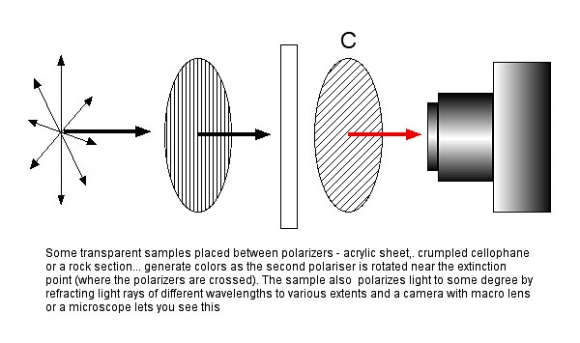
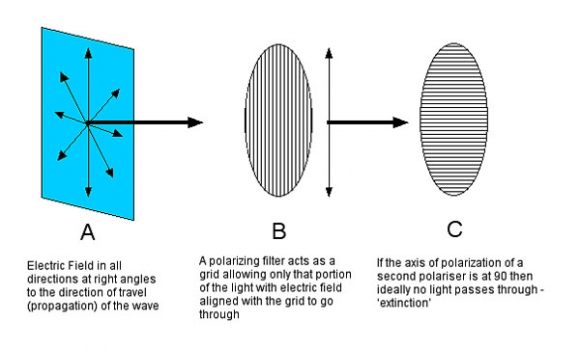
If you place a very thin rock section between the polarizers, the crystals in the rock will themselves polarize the light within their structure. There is another process at work here called bi-refringence where a crystal refracts light differently along two separate axes and the light is split - hence the colors that appear.
An adhoc set up
I could not resist photographing my brother's slides, so I dug out two old circular polarizers – these are the kind you need to use so your setup is compatible with cameras' autofocus and exposure systems. They have a very thin coating layer that shifts the phase of the polarized light by 1/4 of a wavelength, to produce circularly polarized light. Linearly polarized light can cause exposure errors or difficulty in focusing; circularly polarized light avoids these issues.. An aside if you're following along at home: make sure your circular polarizers are oriented in the same direction (with their screw threads in the same direction).
The Contraption
This is one of those projects relying on discarded wood blocks, rubber bands and bailing twine that I love so much: low budget, high effectiveness photography!
Lighting
I used an LED table lamp to focus on the slides, and a flash run from the camera via its E-TTL connection as the main light source. I constructed a simple wooden stand and rotated the polarizer until I obtained the maximum color. The results are a bit more vivid than a true geologist might like, but this is art – not science!
The Lenses
The lenses used for these photos were a pair of Nikon microscope objectives (x4 and x10, for a 160mm tube length) that cost me less than $100 each and are exceptional when used on a bellows. In fact, they are as good as the Zeiss Luminars I have, but more on that in a future post...
Focusing
I focused the lazy way, connecting my camera to a laptop via Helicon Remote to get a large on-screen image. The focusing could not be automated with these lenses, so I just took several pictures, tweaking the focus each time.
Rock section slides
The photos in this post are of rock slides purchased from GEOSEC Slides and beautifully prepared by Rob Gill. The slides are laborious to produce but are an incredible value, considering each one provides a gallery of images: simply moving the slide lets you isolate different sections to create different compositions.
Materials & sources
GEOSEC slides is a wonderful source, but you can also pick up rock slides on eBay.
The best source for polarizing microscopes is eBay, where they frequently go for bargain prices.
